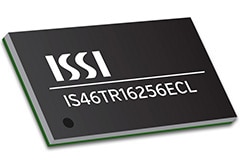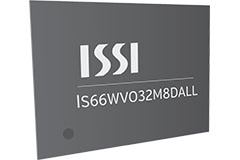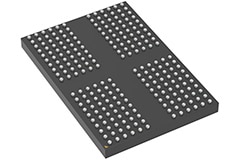 DRAMs with On-Chip Error Correcting Code (ECC)
Publish Date: 2025-03-10
DRAMs with On-Chip Error Correcting Code (ECC)
Publish Date: 2025-03-10
ISSI DRAMs with on-chip error correcting code (ECC) simplify system designs, save power, and reduce the memory footprint on boards.

ISSI Serial NAND Flash devices offer high-density SPI-compatible solutions with x1, x2, and x4 support, ideal for industrial and automotive applications.
ISSI's brochure for their low pin count RAM solutions.
 Serial RAM and Quad RAM Solutions
Publish Date: 2024-04-04
Serial RAM and Quad RAM Solutions
Publish Date: 2024-04-04
ISSI's serial RAM and quad RAM offer low pin count RAM solutions that are ideal for medical and wearable applications.
ISSI's brochure for their serial and quad RAM products.
Today, ISSI offers 3.3V SDRAM, DDR, DDR2, DDR3, as well as Low Power SDRAM, LPDDR and LPDDR2 DRAM.
ISSI's automotive memory solutions.
 Legacy DRAM Featuring DDR3
Publish Date: 2023-10-12
Legacy DRAM Featuring DDR3
Publish Date: 2023-10-12
ISSI’s DDR3 DRAM options are available in densities from 1 Gb to 16 Gb with long-term support.
ISSI eMMC NAND Flash Memory offers unparalleled performance and endurance, including an enhanced mode that allows configuration as a pseudo-SLC.
 Octal Memory Solutions
Publish Date: 2023-04-13
Octal Memory Solutions
Publish Date: 2023-04-13
ISSI’s octal bus xSPI-compliant Flash and RAM devices are for instant-on high-performance applications.
 eMMC NAND Flash Memory
Publish Date: 2023-03-15
eMMC NAND Flash Memory
Publish Date: 2023-03-15
ISSI's eMMC NAND Flash memory devices support an enhanced mode where the device can be configured as pseudo-SLC (pSLC) for higher read/write performance.
ISSI introduces its new Family of IS25LP and IS25WP/WJ series of flash devices. The family builds upon the success of ISSI’s IS25LQ and IS25WQ family by introducing leading edge features such as double data rate* interface modes, SFDP support, and the popular 2 cycle instruction input.
The ISSI LPDDR4 and LPDDR4X are low-voltage memory devices available in 2, 4, and 8 gigabit densities. The devices are organized as one or two channels per device where each channel is eight banks and 16-bits.
Designers can quickly implement occupancy monitoring using a drop-in kit based on a proprietary algorithm running on a low-power digital signal processor.
A specialized processor and software library offer a simpler, safer alternative for face-based authentication.
 LPDDR4/4X Mobile SDRAM
Publish Date: 2020-08-14
LPDDR4/4X Mobile SDRAM
Publish Date: 2020-08-14
ISSI’s LPDDR4/4X mobile SDRAM use a double-data-rate architecture to achieve high-speed operations and are available in 2 Gb, 4 Gb, and 8 Gb densities.
Use RISC-V to customize the instruction set and hardware for the optimum energy profile for an embedded system.
Understand the fundamentals of embedded memory—EEPROM vs FRAM vs eMMC vs SD Cards—to know which ones to use, where, and how.








